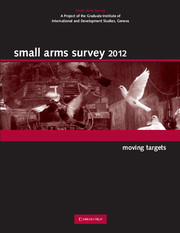Book contents
- Frontmatter
- Foreword
- Contents
- About the Small Arms Survey
- Notes to readers
- Acknowledgements
- Introduction
- Chapter 1 A Fatal Relationship: Guns and Deaths in Latin America and the Caribbean
- Chapter 2 When Business Gets Bloody: State Policy and Drug Violence
- Chapter 3 A Matter of Survival: Non-lethal Firearm Violence
- Chapter 4 Blue Skies and Dark Clouds: Kazakhstan and Small Arms
- Chapter 5 Between State and Non-state: Somaliland's Emerging Security Order
- Photo Essay. Troubled Waters: Somali Piracy
- Chapter 6 Escalation at Sea: Somali Piracy and Private Security Companies
- Chapter 7 Precedent in the Making: The UN Meeting of Governmental Experts
- Chapter 8 Piece by Piece: Authorized Transfers of Parts and Accessories
- Chapter 9 Point by Point: Trends in Transparency
- Chapter 10 Surveying the Battlefield: Illicit Arms in Afghanistan, Iraq, and Somalia
- Index
Chapter 4 - Blue Skies and Dark Clouds: Kazakhstan and Small Arms
Published online by Cambridge University Press: 05 February 2015
- Frontmatter
- Foreword
- Contents
- About the Small Arms Survey
- Notes to readers
- Acknowledgements
- Introduction
- Chapter 1 A Fatal Relationship: Guns and Deaths in Latin America and the Caribbean
- Chapter 2 When Business Gets Bloody: State Policy and Drug Violence
- Chapter 3 A Matter of Survival: Non-lethal Firearm Violence
- Chapter 4 Blue Skies and Dark Clouds: Kazakhstan and Small Arms
- Chapter 5 Between State and Non-state: Somaliland's Emerging Security Order
- Photo Essay. Troubled Waters: Somali Piracy
- Chapter 6 Escalation at Sea: Somali Piracy and Private Security Companies
- Chapter 7 Precedent in the Making: The UN Meeting of Governmental Experts
- Chapter 8 Piece by Piece: Authorized Transfers of Parts and Accessories
- Chapter 9 Point by Point: Trends in Transparency
- Chapter 10 Surveying the Battlefield: Illicit Arms in Afghanistan, Iraq, and Somalia
- Index
Summary
INTRODUCTION
In May 2011, two deadly explosions targeted facilities of Kazakhstan's National Security Committee (KNB) in Aktobe Oblast and Astana. One of the attacks was reportedly the first suicide bombing in the country (Lillis, 2011a). Two months later, in the same oblast, authorities conducted a two-week operation in the villages of Shubarshi and Kenkiyak to neutralize an armed group responsible for the killing of two police officers and suspected of religious radicalism. The special units killed nine members of the group and lost two more officers during the intervention (MIA, 2011; Mednikova and Bogatik, 2011). While Kazakhstan is generally perceived as a beacon of stability in an otherwise troubled region, such incidents demonstrate that economic growth and political stability do not render a country immune to home-grown armed violence.
Kazakhstan has been an active participant in the UN small arms process, submitting four national reports on its implementation of the UN Progamme of Action since 2005 (PoA-ISS, 2010). The country has carried out a well developed set of small arms control initiatives, including strengthened controls over private firearm ownership, large-scale civilian weapons collection, and the destruction of excess stockpiles of arms and ammunition inherited from the Soviet Union (RoK, 2010a). Yet beyond Kazakhstan's own national reporting, the country's small arms control efforts, as well as the nature and significance of the threats they are meant to address, have only rarely been studied. Indeed, the bulk of international attention on small arms issues in Central Asia has been directed at the country's conflict-ridden neighbours.
- Type
- Chapter
- Information
- Small Arms Survey 2012Moving Targets, pp. 106 - 145Publisher: Cambridge University PressPrint publication year: 2012



